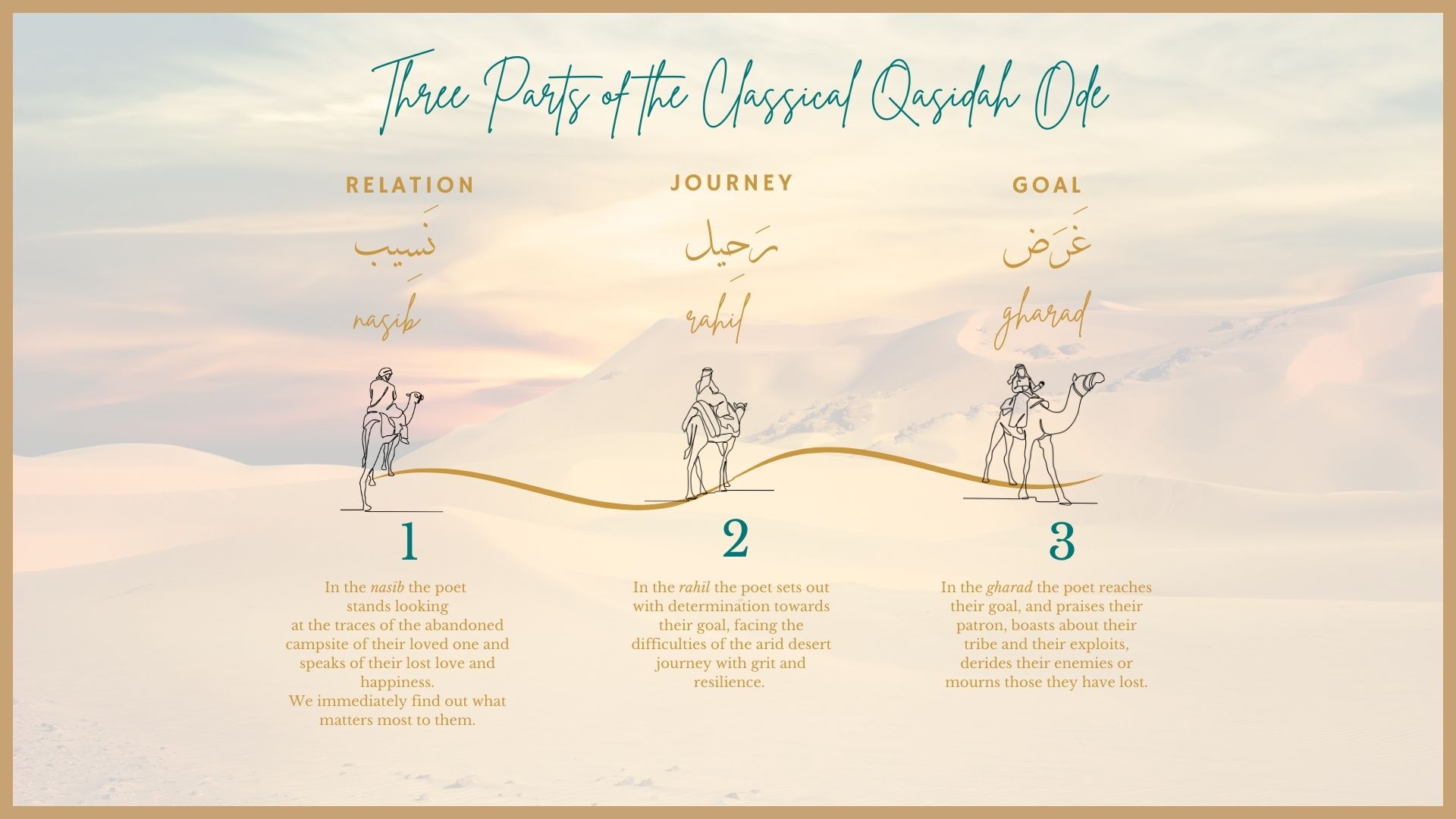MAKTABA: WRITE YOUR NOVEL
CONNECTING WITH YOUR CHARACTERS
Free Writing Lesson: Connect with your story characters
Learn how to write your novel more easily by connecting on a deeper level with with your story characters with this free writing lesson, learning valuable lessons from the enduring works of Rumi, Fariduddin Attar and Ibn Arabi.
If you’re finding writing your novel difficult, connecting with your story characters more deeply may well be the missing piece that will allow your plot to fall into place, your creativity to take off and the words to flow, so that you can more powerfully articulate the story you want to tell.

Lesson One: Traces in the Sand
What Matters Most
(TRANSCRIPT)
يا خَلِيلَيّ عَرّجَا بعِناني
لأرى رسمَ دارِها بعِياني
O my two friends, turn aside [as I do] with my reins
that I may see the form of her abode clearly
Assalamu alaikum! Welcome to this lesson on connecting with your characters to write your novel. One of the most important factors in writing a successful novel is connecting with your characters. You need to understand what really matters to them and why. Without this understanding you may find your novel is difficult to write and that you don’t really feel it is flowing well. You may also find that your readers are not really that excited about your characters or your story. To write a tale that readers are gripped by we need to care about the characters, and unless we connect with them, they will not seem realistic and will not really hold our attention. This lesson looks at some amazing examples we have in literature from the Muslim world where authors connect with their characters to deliver powerful stories that have stood the test of time. We will look at examples of character connection in the works of Fariduddin Attar, Ibn Arabi and Rumi.
Describing what your character looks like, how many brothers and sisters they have, where they are from and what their hobbies are can help you and your reader get some understanding of your character, but these are mostly surface details. To connect on a deeper level you need to work out what is most important to your character and why. What do they really care about? What events in their past have shaped their attitudes to life? What emotional wounds do they carry and what emotional armour do they wear to protect themselves? In order to connect with your character as the writer, and so that your reader can also connect with them, first you need to understand the main interests and concerns they have and why these are important to them.
Let’s look at the traditional classical Arabic qasida ode. The powerful psychological journey it contains has made it an enduring artform through many centuries. Divided into three parts, the beginning section was called the nasīb or relation, connecting the poet to other people that matter to them and to their background. In these opening verses the poet is usually found lamenting over the traces left at the abandoned campsite of their beloved. We are immediately introduced to what concerns the poet most, to their deepest emotions of loss. We know right away what they really care about, and we connect with this deep emotion on a human level. We find ourselves immediately in their deep emotions. We witness them as they acknowledge and accept their loss, and then move from this to their perilous desert journey towards their goal.
The second part of the qasida poem is called the raḥīl or journey, and here the poet pulls themself together to move on from their memories and the campsite, needing grit and determination to face the hardships of the road on the way to their destination. Finally, the third part of the qasida is called the gharad or goal. This part of the poem can have different forms, including praise, boasting, satire and elegy. The poet praises their patron, boasts about their tribe and their exploits, derides their enemies or mourns those they have lost. This three part structure is closely aligned to the traditional three acts of story structure that writer’s use to this day, and it also relates closely to the hero’s journey.
When initially connecting with your story character we can look for inspiration to the first part of the qasidah ode, the nasib. Here the poet is often found haunting old ruins or encampments, longing for loved ones or for happier times, so that we connect with what is nearest to their heart. Ibn Arabi begins one of his qasidahs wistfully reminiscing at the abandoned abode of his beloved:
يا خَلِيلَيّ عَرّجَا بعِناني
لأرى رسمَ دارِها بعِياني
فإذا ما بلغتُما الدارَ حُطّا
وبها صاحبايَ فليبكياني
وقِفا بي على الطّلولِ قليلاً
نتباكى ، بلْ أبكي ممَّا دهاني
O my two friends, turn aside [as I do] with my reins
that I may see the form of her abode clearly
When you reach the abode, descend
And there, my friends, weep for me,
Stop with me a little at the ruins
that we may weep, rather, that I may weep because of what befell me.
The start of your novel does not need to be regretful or filled with woe and sorrow though. In the Conference of the Birds Attar introduces the birds with their very human personal foibles and failings, and these work just as effectively to connect us to their main concerns and understand their characters better. These personal weaknesses and failings also offer the opportunity for them to grow and undergo a transformational journey over the course of the story. These excuses and maladaptive attitudes and behaviours are usually a sort of emotional armour that a character has adopted to protect themselves from deeper feelings.
We are introduced to birds who are self-satisfied, ostentatious, miserly, who love solitude, or have a low sense of self-worth, and we learn about their personalities through their excuses about why they can’t travel to the Simorgh’s court. For example the finch complains about its weakness and unworthiness:
The timid finch approached. Her feeble frame
Trembled from head to foot, a nervous flame;
She chirped: “I am less sturdy than a hair
And lack the courage that my betters share;
My feathers are too weak to carry me
The distance to the Simorgh’s sanctuary.
How could a sickly creature stand alone
Before the glory of the Simorgh’s throne?
The world is full of those who seek His grace
But I do not deserve to see His face
And cannot join in this delusive race –
Exhaustion would cut short my foolish days,
Or I should turn to ashes in His gaze.
– Translated by Afkham Darbandi and Dick Davis
For the birds to set out on their spiritual journey and attain their spiritual goal, they must overcome their flaws and failings and their worldly concerns which are holding them back from what really matters.
It’s good for the writer to understand the underlying motivations of their character, even if they do not understand these themselves.
Rumi begins his Masnavi with the words of the reed, complaining about its separation from the reed-bed. This first person, emotion-laden beginning engages us on a deep level, even if it is just a reed who is telling us about the pain of separation!
Listen to the ney, how it tells a tale,
Complaining of separations
“Ever since they cut me from the reed-bed,
Men and women have cried at my lament”
بشنو ازني چون حکایات می کند
از جداییها شکایت می کند
کز نیستان تا مرا ببریدەاند
در نفیرم مرد و زن نالیده اند
Connecting with your protagonist or main characters on a human level is very important both for you as a writer and for your readers. Introducing your character dealing with a struggle or challenge is a good way to do this, as we all have such struggles and challenges in life and so it makes the character relatable. This shouldn’t necessarily be the main challenge or struggle of the book, as we are just getting to know the protagonist, and this bigger struggle or challenge may not yet be apparent. One of the things that makes reading a unique experience is being able to see into the head of another person, and novels are a particularly good medium for the reader to become immersed in another’s worldview. In order to connect with your character you need to see your story through your character’s eyes. For this reason, the point of view of your book is important. Two points of view that tend to work really well to foster this human connection with your main characters are first person and close third person Deep Point of View. In these points of view you are firmly in the character’s head and describe the story through their eyes, making sure you do not include information they would not know.
Writing Exercises:
Sign up below to receive a worksheet with the writing exercises for this lesson.
Imagine your story is like a qasidah ode.
In the beginning nasib section, what is your character thinking about before they set out on their journey? What is the thing closest to their heart?
In the second rahil journey section, what are the difficulties and trials they encounter on their journey? How do they overcome them?
In the final gharad goal section, what is their goal? Do they celebrate their exploits when they get there? Do they mourn and reflect on what they have lost?
We hope you have enjoyed this free lesson on connecting with your characters to write your novel. If you have a friend who is a writer who you think would enjoy and benefit from this lesson please share it with them. You may also enjoy the rest of the lessons in this short course which go more deeply into these ideas and include writing activities. In lesson two, The Thorn in the Foot and the Thorn in the Heart, we concentrate on wounds and flaws, and your character’s backstory. In lesson three, The Simorgh’s Court: The Goal and the Quest, we will look at how connecting with your character can help you plot the main elements of your novel, with a consideration of your character’s goals, motivations, excuses and personal stakes and how these can help them to overcome their flaws. In lesson four Point of View and Why it Matters we will take a deeper dive into the point of view to write your novel from and why this is important, and in lesson five you will fill out a character worksheet with the most important pieces of information for you to know about your character.
Free Writing Lesson: Connect with your story characters
Learn how to write your novel more easily by connecting on a deeper level with with your story characters with this free writing lesson, learning valuable lessons from the enduring works of Rumi, Fariduddin Attar and Ibn Arabi.
If you’re finding writing your novel difficult, connecting with your story characters more deeply may well be the missing piece that will allow your plot to fall into place, your creativity to take off and the words to flow, so that you can more powerfully articulate the story you want to tell.
Free Lesson: Connect more deeply with your characters, with lessons from the work of Rumi, Attar and Ibn Arabi
In this lesson we look at techniques from the classical qasidah ode, Fariduddin Attar’s Conference of the Birds, and Rumi’s Masnavi to connect with story characters more deeply so that readers relate to them on a more personal level, and keep turning the pages to find out what happens next.

Learn to connect more deeply with your characters to deliver a more powerful story, with examples from the storytelling traditions of the Muslim world.


